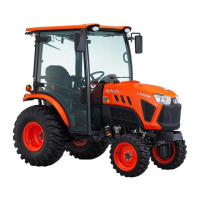• Be
sure to stop the engine before checking the
oil level.
1. Park the machine on a flat surface.
2. Check the engine oil before starting the engine or 5
minutes or more after the engine has stopped.
3. To check the oil level, pull out the dipstick, wipe it
clean, replace it, and pull it out again. Check to see
that the oil level lies within the crosshatched area.
If the level is too low, add new oil to the prescribed
level at the oil inlet.
(See LUBRICANTS, FUEL AND COOLANT on
page 106.)
[LX3310]
(1) Oil inlet
(2) Dipstick
(A) Oil level is acceptable within
this range.
[LX2610/LX2610SU]
(1) Oil inlet
(2) Dipstick
(A) Oil level is acceptable within
this range.
IMPORTANT :
• When
using an oil of different manufacturer
or viscosity from the previous one, remove
all of the old oil.
Never mix 2 different types of oil.
• If the oil level is low, do not run the engine.
• In adding engine oil, use a funnel or the like,
which could prevent the oil from getting
splashed on hot spots.
5. Checking transmission fluid level
1. Park
the machine on a flat surface, lower the
implement and shut off the engine.
2. To check the oil level, pull out the dipstick, wipe it
clean, replace it, and pull it out again. Check to see
that the oil level lies within the crosshatched area.
If the level is too low, add new oil to the prescribed
level at the oil inlet.
(See LUBRICANTS, FUEL AND COOLANT on
page 106.)
(1) Oil inlet
(2) Dipstick
(A) Oil level is acceptable within
this range.
IMPORTANT :
•
If the oil level is low, do not run the engine.
6. Checking coolant level
WARNING
T
o avoid personal injury or death:
• Do not remove the radiator cap while the
coolant is hot. When cool, slowly rotate the cap
to the first stop and allow sufficient time for
excess pressure to escape before removing the
cap completely.
1. Check
to see that the coolant level is between the
[FULL] and [LOW] marks of the recovery tank.
DAILY CHECK PERIODIC SERVICE

